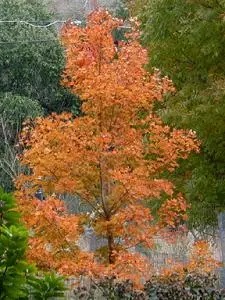News and announcements from our committee chairs, board members, and chapter leaders. Subscribe to our mailing list to stay up to date. For chapter news, visit Chapters. If you are looking for a calendar of events, see our Events Calendar.

June 2006
NICE! Plant of the Month (Chasmanthium latifolium) Family: Poaceae Other Common Names: Broadleaf woodoats, River-oats Type: Native Ornamental Grass Natural Habitat: Moist woodland soils, along streams, ditches, and lakes from Arizona to Florida, Michigan to New Jersey. Growth: 24- to 48-inch perennial that can form thick mats. Preferred Site and

May 2006
NICE! Plant of the Month (Leucaena retusa) Family: Fabaceae Other Common Names: Goldenball Leadtree Type: Deciduous tree Natural Habitat: Dry canyons of southwestern Edwards Plateau, Trans-Pecos Mountains, northern Mexico, and southern New Mexico Growth: Loose shrub or small tree 12 to 15 ft. tall but can reach 25 ft. Preferred

April 2006
NICE! Plant of the Month (Callirhoe involucrata) Family: Malvaceae (Mallow) Other Common Names: Poppy-mallow; Spreading winecup Type: Perennial Natural Habitat: throughout Texas except far West Texas Growth: 6 to 12 inches with some 18-inch trailing stems in a low-growing mound. Tuber with green rosette in winter. Preferred Site and Use:

March 2006
NICE! Plant of the Month (Philadelphus ernestii or Philadelphus texensis) Family: Hydrangeaceae, Saxifragaceae Type: Shrub; 1-3 feet, much-branched, slender stems, peeling bark. Natural Habitat: Endemic to Texas Hill Country. Preferred Site and Use: Moist shady canyon or bluff walls. Deer Resistance: Readily browsed. Wildlife: None noted. Light Tolerance: Partial shade.

February 2006
NICE! Plant of the Month (Symphoricarpos orbiculatus) Family: Caprifoliaceae (Honeysuckle family) Other Common Names: Indian Currant, Buckbrush, Turkeybush, and Snowberry Type: Shrub; 2 to 4 feet in the Hill Country. Natural Habitat: Woodlands, thickets, and along streams in eastern third of Texas and the eastern U.S. Growth: rapid growth, short-lived,

January 2006
NICE! Plant of the Month (Ilex vomitoria) Description:Yaupon Holly may be grown as a multitrunked shrubby or single trunked small tree. It is native across the entire Southeastern US with its western range extending into central Texas. In the Hill Country it seldom reaches its potential height of 25 ft.
Our Society’s home in Fredericksburg
The core of the house was built in the early 1880’s by the Staudt family and used as a Sunday House. At that time families that lived in the country often built a small two-story two-room house in town where they could stay on weekends when they shopped for supplies on Saturday and attended church on Sunday.

July-August 2005
NICE! Plant of the Month (Yucca rupicola) Description:Endemic to the Edwards Plateau, Twist-leaf yucca gets its name from its wonderful twisting leaves. It is a low-growing yucca without a visible stem with single or clustered heads of twisted, arching blue-green leaves 8-24 inches long. Flowers are held on stalks as

May 2005
NICE! Plant of the Month (Stachys coccinea) Description:Texas Betony, is a flowering and evergreen perennial, 12 to 18 inches tall or more. It naturally grows in moist crevices of the mountains of West Texas, west to Arizona, and northern Mexico. It produces red or pink tubular flowers and has a

April 2005
NICE! Plant of the Month (Gelsemium sempervirens) Description:Carolina Jessamine is an evergreen, perennial, flowering vine. Its natural range includes East Texas and much of the southeastern U.S. It produces fragrant, yellow, funnel-shaped flowers and is often one of the first plants to bloom in the spring. Gelsemium sempervirens has glossy

March 2005
NICE! Plant of the Month (Acer grandidentatum) Description:Bigtooth maple is a relic from the last ice age, 10,000 years ago. It is a native hardwood shrub or medium sized-tree of 20-30 feet, but under optimal conditions it can reach up to 50 feet tall. It has an open, rounded crown

February 2005
NICE! Plant of the Month (Opuntia engelmannii variety lindheimeri) Description:Texas Prickly Pear Cactus belongs to the Opuntia genus or group of cacti and is the most prevalent species of Opuntia found in Texas. Its natural range is from the Western Cross-Timbers, Rolling and High Plains, Edward’s Plateau, Rio Grande Plains,


